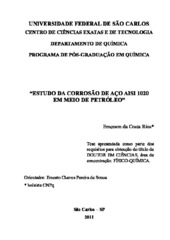Estudo da corrosão de aço AISI 1020 em meio de petróleo
Abstract
The chemical attack on crude oil, which contains corrosive compounds such as H2S, CO2, naphthenic acids and salts dissolved in the aqueous phase, combined with effects of varying pH, temperature, flow and pressure, has great influence on the corrosion rate in equipment steel. Given the small number of papers in the literature relating to the study of corrosion of steel in contact with crude oil, and the importance of the topic, this study aimed to characterize the main corrosion of steel AISI 1020, which has similar chemical composition most of the steel pipelines in oil. Due to the high resistivity of oil, this study used the techniques of Electrochemical Impedance Spectroscopy, EIS, and Electrochemical Noise, EN, for the measurements of steel corrosion. Initially tests were carried out mass loss in steel samples immersed in simulated oil with different amounts of acetic acid in order to define the concentrations and their corrosive effects. Considering the oil contained in the aqueous phase were studied by EIS types of steel corrosion in oil OAPI 17 with different amounts of sea water emulsified. The spectra obtained by EIS showed three semi-circles, and at high frequencies (> 10Hz), the predominant effect of the capacitive and resistive bulk oil and in medium (10 - 0.05 Hz) and low (<0.05 Hz) frequencies the effects of adsorption, electrical double layer and charge transfer resistance at the interface of the electrode is predominant. Optical images were obtained after the accelerated corrosion of steel/emulsions systems and for polarization curve measurements in situ of the steel/water extract, where there was variation in the morphology of the attack with the variation in the amount of water emulsified in oil. Considering the presence of corrosive three species: sea water (0.5 and 4.0%), naphthenic acid (500 and 3,000 ppm) and H2S (50 ppm and 1,000), and using a 23 factorial design of experiments to obtain the effect cross these species, the corrosion process was investigated using the technique of EN in the open circuit potential, EOC. Analysis of current noise signals was done with the help of wavelet transform which gave rise to the power distribution diagrams. These diagrams show that there is a greater tendency to pitting corrosion in environments where the concentration of H2S the amount of water are higher, which means that for the greater amount of naphthenic acid corrosion in general the contribution was relatively higher. The results observed through the power distribution diagrams were confirmed by morphological analysis of the samples corroded. The methods used in this work allowed to estimate the speed and identify the predominant type of corrosion of steel in oil containing aggressive chemical species that are commonly found in Brazilian petroleum.
